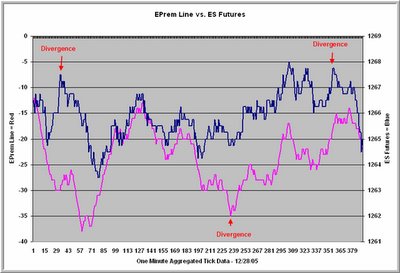OK, now we'll start looking at price momentum patterns. For sake of consistency, I'll look at the period from July, 2003 to the present (N = 615 trading days)--the same period used in the prior analyses. For this particular analysis, we're looking at the past three day price change in the S&P 500 (SPY) and seeing how it is related to the next three days in SPY, QQQQ (NASDAQ 100), and MDY (S&P Midcaps). Both the Qs and MDY have outperformed SPY handily over this period and have also displayed superior volatility. The idea is that these might do a good job of exploiting any momentum patterns.
For the sample overall (N = 615), the average three-day change has been .12% (362 days up, 253 down). When the last three days in SPY have been up by 1.40% or more (N = 80), the next three days in SPY, QQQQ, and MDY respectively have been .29% (58 up, 22 down), .69% (55 up, 25 down), and .48% (58 up, 22 down). Clearly, strong upside three-day price momentum by SPY has been followed by three days of further strength. The greatest followup strength has been seen in QQQQ and MDY, as hypothesized.
When the last three days in SPY have been down by 1.2% or greater (N = 80), the next three days in SPY, QQQQ, and MDY respectively have been .34% (54 up, 26 down), .20% (41 up, 39 down), and .45% (53 up, 27 down). Once again, we see price outperformance by SPY and MDY after three days of strong negative price change--but we don't see the same with QQQQ. Interestingly, QQQQ seems to magnify SPY strength in its reaction the next three days, but also rebounds less following three days of SPY weakness. Findings such as these might help guide traders in selecting what to trade following strength and weakness.
The price-based momentum findings are similar to those obtained with the Supply/Demand momentum measures. Momentum seems much better at forecasting future short-term strength than weakness.
What we
can say regarding weakness is that moderate levels of three-day SPY momentum tend to produce subnormal returns three days later. When SPY momentum is moderate (N = 455), the next three-day return in SPY, QQQQ, and MDY respectively are .06% (250 up, 206 down), .07% (247 up, 208 down), and .13% (256 up, 199 down). A possible implication I need to study is that the odds of a trend day in the averages are reduced following periods of moderate momentum.
Next I'll turn the tables and see how the averages perform following price strength and weakness in the QQQQ and MDY.





